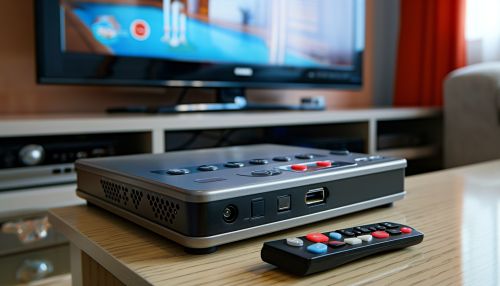Digital Media Player
Introduction
A digital media player (DMP) is an electronic device designed to store, organize, and play digital media files such as audio, video, and images. These devices can be standalone units or integrated into other electronic systems such as smart TVs, home theater systems, and automobile infotainment systems. Digital media players have evolved significantly since their inception, incorporating advanced features such as internet connectivity, streaming capabilities, and support for high-definition and 4K content.
History
The development of digital media players can be traced back to the late 20th century with the advent of digital audio players. The first commercially successful digital audio player was the MPMan, released in 1998. This device paved the way for subsequent innovations, including the Apple iPod in 2001, which revolutionized the market with its user-friendly interface and integration with iTunes.
The transition from audio to video media players began in the early 2000s, with devices like the Archos Jukebox Multimedia and the Microsoft Zune. These early video players supported various file formats and offered limited storage capacity. The introduction of smartphones and tablets further blurred the lines between dedicated media players and multifunctional devices.
Types of Digital Media Players
Digital media players can be categorized into several types based on their functionality and usage:
Portable Media Players
Portable media players (PMPs) are compact devices designed for on-the-go use. They typically feature built-in storage, a display screen, and support for various media formats. Examples include the Apple iPod Touch, Sony Walkman, and SanDisk Sansa.
Network Media Players
Network media players, also known as streaming media players, connect to the internet to stream content from online services such as Netflix, Hulu, and Spotify. These devices often support high-definition and 4K resolution, and may include features like voice control and integration with smart home systems. Popular models include the Roku, Amazon Fire TV, and Google Chromecast.
Home Theater Media Players
Home theater media players are designed to be integrated into home entertainment systems. They offer advanced features such as support for surround sound, high-definition video, and extensive connectivity options. Examples include the NVIDIA Shield TV and the Apple TV.
Automobile Media Players
Automobile media players are integrated into vehicle infotainment systems, providing entertainment and navigation features. These players often support Bluetooth connectivity, voice commands, and integration with smartphone apps. Examples include the Android Auto and Apple CarPlay systems.
Technical Specifications
Digital media players vary widely in terms of technical specifications. Key aspects to consider include:
Storage Capacity
Storage capacity is a critical factor, determining how much media content can be stored locally. Storage options range from built-in flash memory to expandable storage via SD cards or external hard drives.
File Format Support
Support for various file formats is essential for compatibility with different media types. Commonly supported audio formats include MP3, AAC, and FLAC, while video formats may include MP4, AVI, and MKV.
Connectivity
Connectivity options are crucial for accessing and transferring media content. Common connectivity features include Wi-Fi, Bluetooth, HDMI, and USB ports.
Display and User Interface
The display and user interface play a significant role in the user experience. High-resolution screens, touch interfaces, and intuitive navigation are key features of modern digital media players.
Advanced Features
Modern digital media players come equipped with a range of advanced features to enhance the user experience:
Voice Control
Voice control allows users to interact with their media player using voice commands. This feature is often integrated with virtual assistants such as Amazon Alexa, Google Assistant, and Apple Siri.
Streaming Services Integration
Integration with popular streaming services enables users to access a vast library of content. Services like Netflix, Amazon Prime Video, and Spotify are commonly supported.
Smart Home Integration
Smart home integration allows digital media players to interact with other smart devices in the home. This can include controlling lights, adjusting thermostats, and managing security systems.
High-Resolution Audio and Video
Support for high-resolution audio and video formats ensures a superior media experience. This includes 4K video, HDR (High Dynamic Range), and lossless audio formats like FLAC and ALAC.
Multi-Room Audio
Multi-room audio capabilities enable users to play synchronized music across multiple rooms using compatible speakers and devices. This feature is often managed through apps and services like Sonos and Google Home.
Market Trends and Future Developments
The digital media player market is continuously evolving, driven by advancements in technology and changing consumer preferences. Key trends and future developments include:
Increased Streaming Adoption
As internet speeds and connectivity improve, more consumers are shifting towards streaming services for their media consumption. This trend is expected to continue, with digital media players increasingly focusing on streaming capabilities.
Integration with Artificial Intelligence
Artificial intelligence (AI) is playing a growing role in enhancing the functionality of digital media players. AI can be used for personalized content recommendations, voice recognition, and automation of routine tasks.
Enhanced Connectivity
The adoption of new connectivity standards, such as Wi-Fi 6 and 5G, will enable faster and more reliable media streaming. This will also facilitate the integration of digital media players with other smart devices.
Expansion of High-Resolution Content
The availability of high-resolution content, including 4K and 8K video, is expected to increase. Digital media players will need to support these formats to remain competitive.
Sustainability and Energy Efficiency
As environmental concerns grow, there is a push towards more sustainable and energy-efficient digital media players. This includes the use of eco-friendly materials and the development of low-power consumption technologies.
See Also


